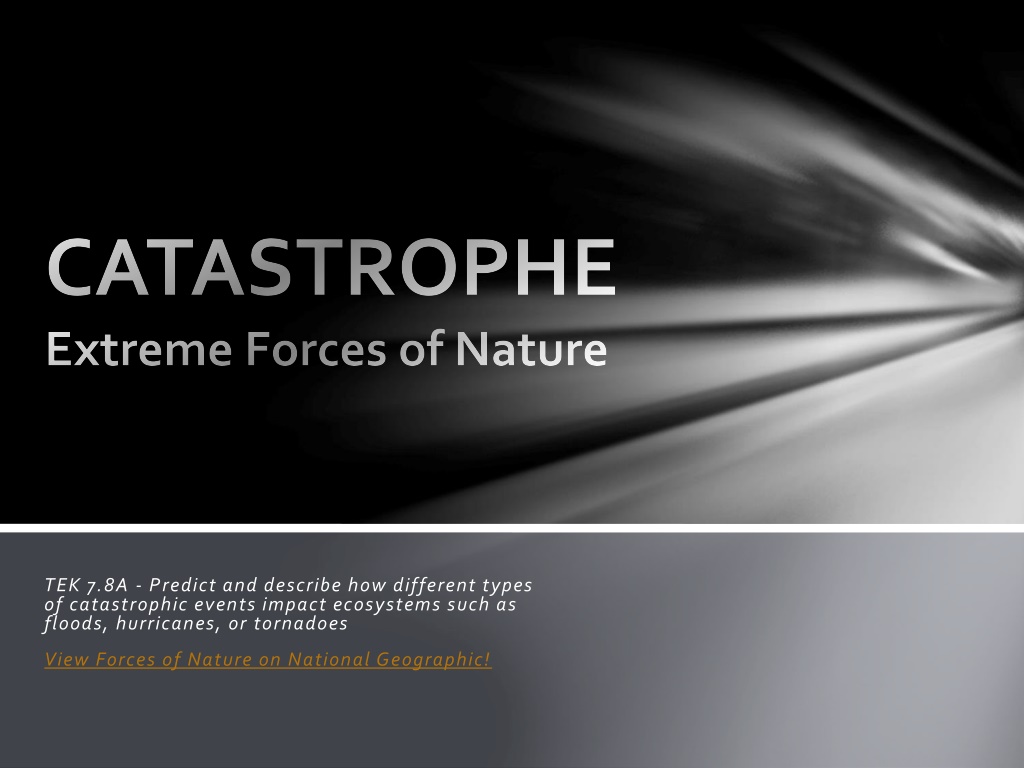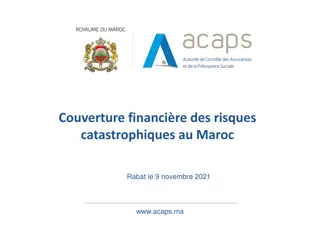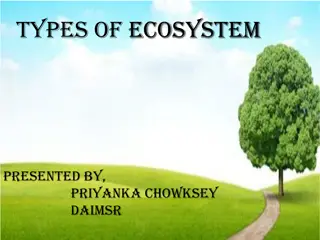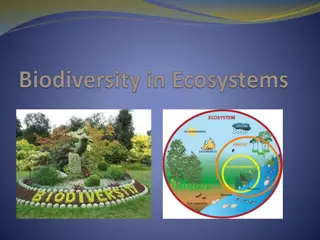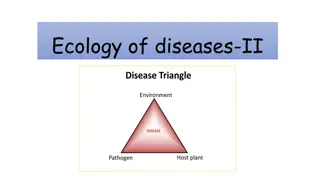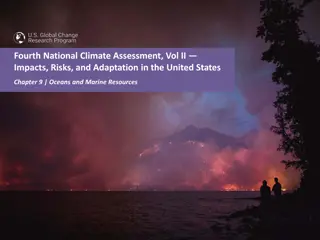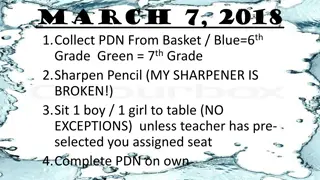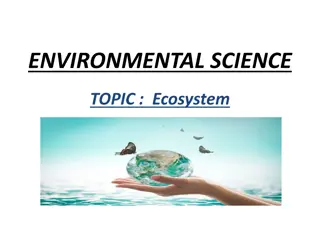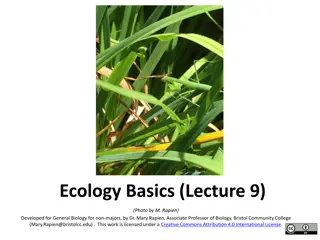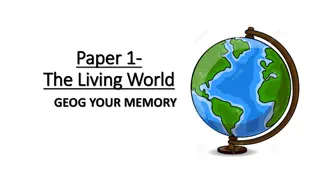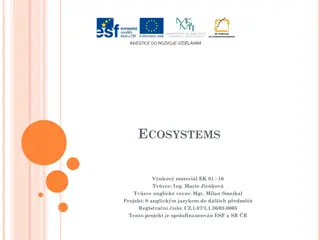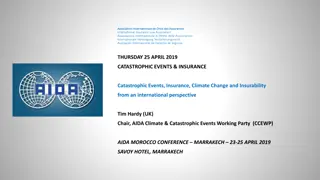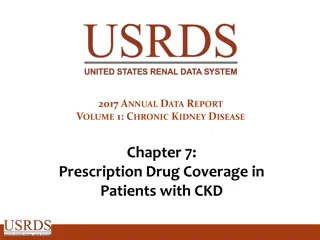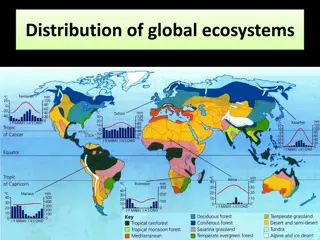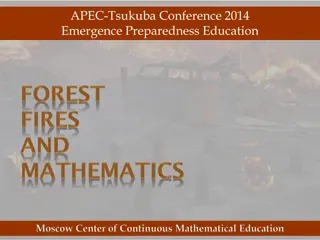Impact of Catastrophic Events on Ecosystems
Catastrophic events like floods, hurricanes, and tornadoes have significant impacts on ecosystems, affecting physical structures, crops, food supplies, vegetation, animal species, disease, famine, and even land features. Hurricanes, for example, cause erosion, disrupt bayous, contaminate water, and result in fatalities. The 1970 Bhola Cyclone in India and East Pakistan stands as the deadliest tropical cyclone on record, claiming hundreds of thousands of lives and causing extensive damage.
Download Presentation

Please find below an Image/Link to download the presentation.
The content on the website is provided AS IS for your information and personal use only. It may not be sold, licensed, or shared on other websites without obtaining consent from the author.If you encounter any issues during the download, it is possible that the publisher has removed the file from their server.
You are allowed to download the files provided on this website for personal or commercial use, subject to the condition that they are used lawfully. All files are the property of their respective owners.
The content on the website is provided AS IS for your information and personal use only. It may not be sold, licensed, or shared on other websites without obtaining consent from the author.
E N D
Presentation Transcript
CATASTROPHE Extreme Forces of Nature TEK 7.8A - Predict and describe how different types of catastrophic events impact ecosystems such as floods, hurricanes, or tornadoes View Forces of Nature on National Geographic!
Natural Disasters Effects on Environment Physical structures TORNADO Crops and food supplies HURRICANE Vegetation and animal species Disease and Famine Destroying or creating new land features Can YOU think of more?? FLOOD VOLCANO
View Hurricanes on National Geographic! Hurricanes http://library.thinkquest.org/5431/Effects.htm
Remember your Quiz? 1. When storm winds reach a speed of 75 miles per hour, the storm is officially classified as a Hurricane. 2. Areas near the Equator have the most hurricanes. As you can imagine, the water is much warmer there. 3. The main hurricane season in the North Atlantic is June- November (our Summer months). 4. Hurricanes in the western Pacific are known as typhoons. 5. Storm surges will, in most cases, cause the most death. 6. Warm ocean water (in the Summer months and near the Equator) is the major cause of hurricane formation. 7. A hurricane hunter will fly a plane into the storm to gather more information about the hurricane. 8. A storm surge is severe flooding caused by higher than normal tides. 9. Around the outside of the eye of the hurricane (the eyewall) is where the worst winds are found. Inside the eye is the calmest part of the hurricane.
Hurricanes and the Environment One effect of hurricanes on the environment is they cause erosion. The wind, waves, and high water level, also known as the storm surge, are powerful forces that work away at the environment. The erosion may also destroy structures by pulling the earth away from underneath it.
Hurricanes and the Environment Hurricanes impact bayous by causing a rapid rise in water. High levels of bacteria in the bayou caused by hurricanes make the water unsafe and are responsible for deaths of both people and animals. High, powerful winds are responsible for knocking down houses, trees, and power lines. Hurricanes also cause lightning and tornadoes. Flooding can also be caused by hurricanes.
A Closer Look 1970 Bhola Cyclone Time: Nov. 7 13, 1970 Areas: India, East Pakistan Fatalities: 300,000 500,000 Damage: US$86.4 million (1970 USD) The 1970 Bhola Cyclone is the deadliest tropical cyclone ever recorded in human history. It hit East Pakistan (now Bangladesh) and India's West Bengal on November 12, 1970. On November 12, the storm reached its climax with winds of 185 km/h (115 mph). The massive storm took 300,000 to 500,000 lives. http://www.china.org.cn/top10/2012-11/05/content_27006766_10.htm
Floods A flood is a great flowing or overflowing of water, especially over land not usually submerged. A flood can be caused slowly by excessive rainfall, or very quickly as multiple storms merge together and create a flash flood.
Remember your Quiz? 1. Slow moving and consistent thunder storms and heavy rains from hurricanes and tropical storms are responsible for most flash flooding 2. Both rainfall intensity and duration contribute to flooding. 3. If you come upon flood waters, do not try to fight or swim through it. Move in another direction and get to high ground as soon as you can. 4. It only takes 6 inches of fast moving flood water to knock you off your feet! 5. It only takes 2 feet of fast movie flood water to sweep a vehicle away!
Floods and the Environment Physical damage damage to structures, including bridges, buildings, sewage systems, roadways, and canals. Water supplies Water will become contaminated and clean drinking water will become scarce. Crops and food supplies Entire harvests can be lost and create a shortage of food. Trees Non-tolerant species can die from too much water. Transport Some transport links may be destroyed and obstruct emergency aid.
Floods and the Environment Throughout history, floods have proven to be the deadliest natural disasters. This is mainly due to the high population densities around rivers. Can you think of why people would chose to live by rivers? Not all victims are claimed by the initial floodwaters. Disease and famine that follow the disasters can kill more than the floodwaters themselves.
A Closer Look Huang He (Yellow) River Flood, China 1931 Death Toll: 1,000,000 to 3,700,000 The Huang He River is prone to flooding because of the broad expanse of plain that lies around it. One of the major reasons for the flooding is the high silt content that gives the river its yellow tint (and thus its name). The silt which constitutes as much as 60% of its volume builds up until the river actually is higher than the surrounding land. The tendency to flood is exacerbated by ice dams which block the river in Mongolia; the dams back up the water, and then release devastating walls of water when they break. The history of flooding has prompted the Communist Chinese government to embark on a program of building dams for flood control. The dams, however, have not proven entirely effective and have been the target of criticism from environmentalists. http://www.epicdisasters.com/index.php/site/comments/the_worlds_worst_floods_by_death_toll/
Remember your Quiz? 1. Tornados come from powerful thunderstorms and appear as rotating, funnel shaped clouds. 2. Tornados can reach speeds of 300 MPH. 3. America s highest risk area for tornados is Tornado Alley. 4. If you are caught in the open with a tornado, find a building immediately. If you cannot find a building, laying in a ditch is your next best option. 5. When a tornado is near by, take cover! 6. A tornado watch is when tornados are possibly in your area. 7. Tornado warning is when a tornado has been spotted in your area. 8. A safe room is a special room inside the house designed to withstand high winds and flying debris. 9. Never stay in a car! Cars are easily flung by tornado winds! 10. You can take ALL of the above actions to protect your home.
Tornados and the Environment Tornadoes effect the environment because of their highly intense wind power. Flying debris can be very dangerous and create additional damage. Tornados may cause fires due to damaged power lines and gas leaks.
Types of Tornados Tornados are also known as Twisters. Tornado s Cousins: Firewhirls Gustnados Waterspout Intense heat from a forest fire or volcano eruption cause a funnel of fire and or smoke. Winds can get up to 100 mph. Landspout Tornados Form under cumulonimbus clouds. They are weaker than a Supercell and are the land equivalent of a waterspout tornado appear like dust devils. usually die down when they reach land. Supercell Tornados are formed out of long-lived Supercell thunderstorms. They stay on the ground for the longest amount of time (an hour or more) and can have violent winds exceeding 200 mph Are weak and short-lived. They appear briefly at the front of a thunderstorm as a dust whirl or debris cloud. They usually don t cause as much damage. They Is a tornado over the water. They form from weak and strong thunderstorms. They Dust Devils Resemble gustnados. They are weaker than a real tornado and are found in hot, dry, areas and don t usually reach more than 70 mph.
A Closer Look Daulatpur-Saturia, Bangladesh April 26, 1989 An estimated 1,300 people died from this tornado, which was a mile wide and cut a swath of destruction 50 miles long. The injuries were estimated to be around 12,000. Due to poor housing and construction standards, the tornado completely destroyed virtually every structure it touched. The death toll from this twister is nearly twice as high as the second-deadliest on this list.
Volcano View Volcanoes on National Geographic!
Remember your Quiz? 1. Volcanos are either active, dormant, or extinct. If a volcano has not erupted recently, but we expect it may erupt again, that volcano is called dormant. 2. False. There are more Volcanos on the Earth than we can see above the earth. Many exist under the ocean and may in time form new islands! (That s how we got Hawaii). 3. The tallest volcano is the world is Mauna Kea in the United States! (30000 feet above the ocean floor in Hawaii). 4. Earth is not the only planet in this solar system that has erupting volcanoes. The largest volcano in the solar system is on Mars. Olympus Mons on Mars is almost 3 times bigger than Everest- the largest mountain on earth. 5. Worshiped in ancient Rome, Vulcan was thought to live under an island called Vulcano off the coast of Sicily. The word volcano comes from this island s name. 6. In 1815, Tambora, Indonesia created a death toll of about 10,000 from eruption, another 80,000 killed from famine and disease caused by eruption. 7. Over 75 active Volcanos are within Indonesia's borders.
Volcanoes and the Environment Today there are more than 500 active volcanoes in the word, with about 10-40 eruptions every year. Volcanoes are incredibly destructive to both the environment and the health of the local people. In addition to the hazardous effects of all the forces of nature so far, volcanoes also toxic gasses and steams. This can cause fatal respiratory system issues.
Types of Volcanos Cinder Cones Lava from a single vent Composite volcanoes are steep-sided volcanoes composed of many layers of volcanic rocks. Mt. Rainier and Mount St. Helens are examples of this type of volcano. Composite Volcanoes Shield volcanoes are volcanoes shaped like a bowl or shield in the middle with long gentle slopes made by basaltic lava flows. Shield Volcanoes No central crater. Giant cracks open in the ground and expel vast quantities of lava. Usually leave the plain about as flat as they found it. Fissure Volcano http://www.educationcaribbean.com/resources/encyclopaedia/geography/volcanoes.asp
A Closer Look The city of Pompeii was a Roman town-city near modern Naples that was affected by a Volcano. Pompeii was partially destroyed and buried under 13 to 20 ft. of ash and pumice in the eruption of Mount Vesuvius in AD 79. Vesuvius buried the roman city of Pompeii in August AD 79 after being dormant for 2000 years.
